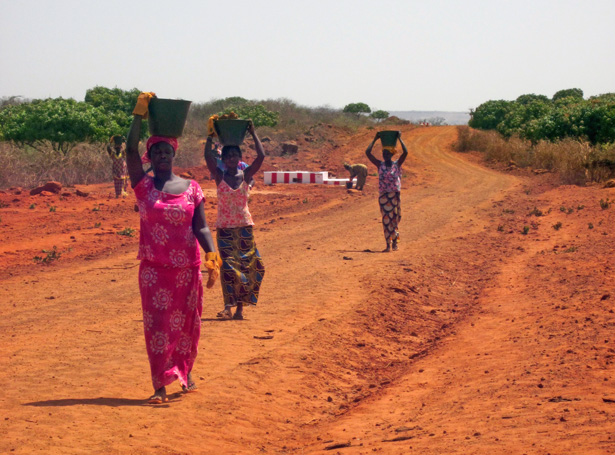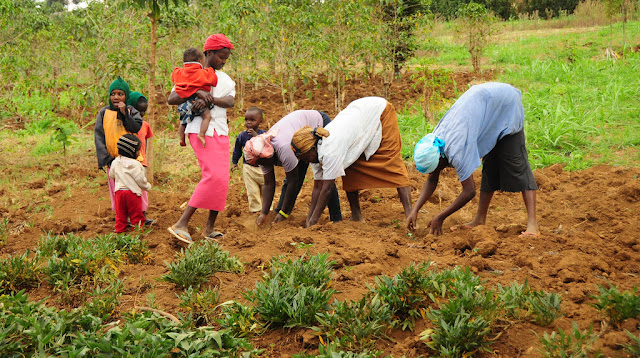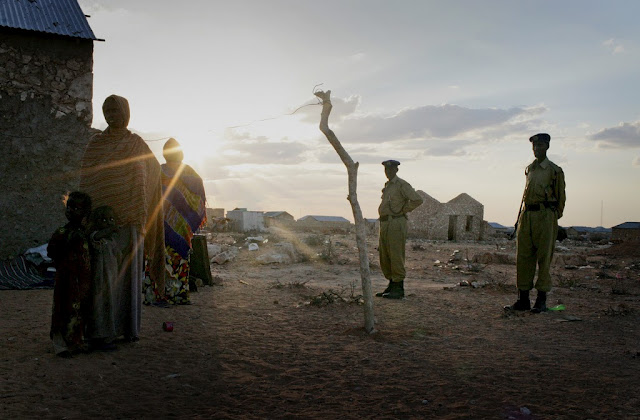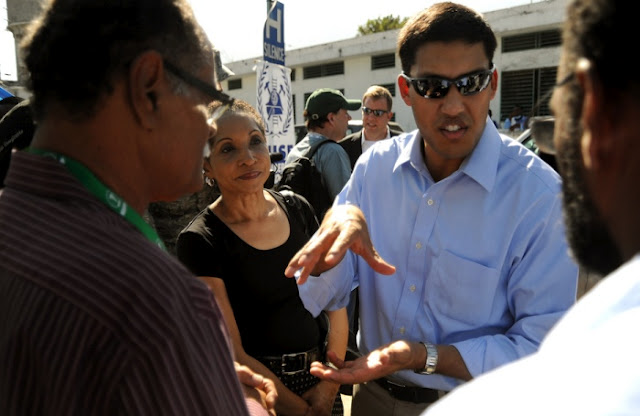-
From Dakar to Abidjan, Population Finally Finding Its Place in Food Security Assessments
›June 20, 2013 // By Kathleen MogelgaardA woman sat crouched on the side of a busy road in Dakar, a baby in a sling on her back and a basket of peanuts in front. I know only a little French, and no Wolof, but I decided to try anyway. “Bonsoir,” I said, and smiled at the toddler beside her. “Combien?” I asked, pointing at the peanuts.
She smiled back at me, we negotiated a sale, and in exchange for the coins in my pocket I walked away with a few bags of the small, tasty nuts that are grown throughout the “peanut basin” of central Senegal.
-
Women in Agriculture: Closing the Gender Gap for Development and World Hunger
›June 22, 2011 // By Kellie FurrProviding women with equal access to productive resources and opportunities may be the key to bolstering the struggling global agricultural sector and feeding communities living in extreme hunger, according to the UN Food and Agriculture Organization’s (FAO) latest State of Food and Agriculture report, which this year is sub-titled, “Women in Agriculture: Closing the Gender Gap for Development.”
“Women are farmers, workers, and entrepreneurs, but almost everywhere they face more severe constraints than men in accessing productive resources, markets, and services,” write the authors. “This ‘gender gap’ hinders their productivity and reduces their contributions to the agriculture sector and to the achievement of broader economic and social development goals.”
Barriers to Productivity
Globally, women comprise 43 percent of the agricultural labor force, ranging from 20 percent in Latin America to 50 percent in southeastern and eastern Asia and sub-Saharan Africa, according to the report. But despite their significant global presence, female farmers face gender-specific constraints that hinder access to productive resources, financial support, information, and services required to be viable and competitive. “The yield gap between men and women averages around 20 to 30 percent, and most research finds that the gap is due to differences in resource use,” write the authors.
Generally, women are more likely than men to hold lower-wage, part-time, or seasonal positions and tend to get paid less even when they are more qualified. Furthermore, domestic and occupational lines are blurred for women, who are often not compensated for work that is closely related to domestic food preparation. Most significantly for agricultural productivity, women across the developing world often lack access to quality land, sometimes being barred from land ownership. This ban precludes female farmers from exercising managerial discretion over farming activities, such as entering contract farming agreements. Women also generally own less livestock and contract for less labor – two crucial assets for marketable agricultural production in many developing countries. Moreover, because of insufficient land and resources, women farmers are also more vulnerable to climate shocks.
Resource barriers for female farmers extend to education, finance, and technology as well. The authors observe that “female household heads in rural areas are disadvantaged with respect to human capital accumulation in most developing countries, regardless of region or level of economic development,” which represents a historical bias against females in education. Despite notable success observed in finance projects involving female farmers, gender bias exists in the financial system, which prevents women from bearing initial financial risk in order to increase long-term productivity gains. Sources of gender bias in the financial sector include legal barriers, cultural norms, lack of collateral, and institutional discrimination by public and private lenders. Due to the aforementioned lack of credit, labor, and education, women farmers are deficient in all aspects of technology, such as the acquisition of new equipment, information about new seed varietals and animal breeds, pest control measures, and management techniques.
Global Implications
Closing the gender gap could have profound implications for easing world hunger. According to the FAO, approximately 925 million people are currently undernourished, most of whom live in developing countries. If women were given all the inputs and support as men, agricultural output could increase by 2.5 to 4 percent in developing countries, potentially reducing the world’s hungry by 100 to 150 million people. “This report clearly confirms that the Millennium Development Goals on gender equality (MDG 3) and poverty and food security (MDG 1) are mutually reinforcing,” FAO Director-General Jacques Diouf argues in his introductory remarks.
Increasing the economic viability of women farmers may also translate into better infant and child health indicators – when women control additional income, they tend to allocate more of their earnings toward the health and well-being of their children. Closing the agricultural gap is “a proven strategy for enhancing the food security, nutrition, education, and health of children,” Diouf asserted. “Better fed, healthier children learn better and become more productive citizens. The benefits would span generations and pay large dividends in the future.”
Finally, the FAO notes that in addition to reducing child mortality rates, increasing female education and economic prosperity helps lower fertility rates, which over time increases human capital and can help drive a demographic transition towards lower dependency rates and higher per capita growth.
Closing the Gender Gap
“The conclusions are clear,” write the authors:1) Gender equality is good for agriculture, food security, and society; and
Though they note that “no simple ‘blueprint’ exists for achieving gender equality in agriculture,” the authors do recommend some basic principles to the development community, including working towards eliminating discrimination against women under the law, strengthening rural institutions and making them gender-aware, freeing women for more rewarding and productive activities, building the human capital of women and girls, bundling interventions, improving the collection and analysis of sex-disaggregated data, and making gender-aware agricultural policy decisions.
2) Governments, civil society, the private sector and individuals, working together, can support gender equality in agriculture and rural areas
Recognizing that “women will be a pivotal force behind achieving a food secure world,” the U.S. Agency for International Development (USAID) has actually launched initiatives aimed directly at closing the gender gap. The Feed the Future initiative, announced last spring, includes a heavy focus on gender equity and integration with small-scale farming initiatives. For example, the Office of Women in Development is supporting a three-year project in Liberia, “Integrated Agriculture for Women’s Empowerment,” that aims to train and support 1,500 small farmers in Lofa county, two-thirds of whom are women. And in Rwanda, USAID helped the Ministry of Agriculture and Animal Resources – headed by Dr. Agnes Kalibata – develop a national investment plan, which has been successful in bringing in donor support.
However, the FAO report does not offer specific feedback on programs like Feed the Future, which is arguably a crucial component of a truly comprehensive assessment on the current state of agriculture. Though they write that the State of Food Agriculture series is intended to simply be “science-based assessments of important issues,” the infancy of these food security efforts and the immediacy of the problems examined (see recent food price instability) creates an excellent opportunity for critical input. “Women in Agriculture” offers perhaps the most comprehensive report on the gender gap and development to date, but more specific critiques on the current efforts of USAID and others might make more of an impact in a field where the issues at play have been fairly clearly enumerated many times before.
Sources: Food and Agriculture Organization, The Hunger Project, International Fund for Agricultural Development, Population Action International, USAID.
Photo Credit: Adapted from “Ngurumo Village-Ntakira (Kenya),” courtesy of flickr user CGIAR Climate. -
Can Food Security Stop Terrorism?
›May 28, 2010 // By Schuyler NullUSAID’s “Feed the Future” initiative is being touted for its potential to help stabilize failing states and dampen simmering civil conflicts. Speaking at a packed symposium on food security hosted by the Chicago Council last week, USAID Administrator Rajiv Shah called food security “the foundation for peace and opportunity – and therefore a foundation for our own national security.”
-
USDA v. Taliban
›May 28, 2010 // By Dan AsinAgricultural development is the “top non-security priority” in Afghanistan, said U.S. Secretary of Agriculture Tom Vilsack, in a recent speech. “Unemployment is the best recruiting tool for the Taliban,” he told the Des Moines Register.
Sixty USDA experts are working with their partners in State, USAID, DOD, and other members of U.S. government to increase agricultural opportunities in rural areas of the country. Embedded in small civil-military units of 15-100 people, USDA experts have worked on projects of all scales: installing windmill water pumps, training veterinarians, refurbishing university research laboratories, stabilizing river banks and irrigation canals, and developing storage facilities.
In his keynote speech at the Feed the Future launch, Vilsack emphasized the need to build markets. In Afghanistan, USDA is focusing on improving infrastructure so farmers can receive deliveries and ship produce, and boosting credit vehicles to help farmers purchase the inputs to grow crops. Opium traders provide seeds to the farmers and pick up the crops at the farms, he said, which makes opium easier to produce than legal crops.
Alternative crops could be just as or more valuable, Vilsack told NPR:Table grapes are in some cases perhaps four and five times more valuable than poppy. Saffron, almonds, pomegranates, a number of fruits are significantly more profitable. What we have to do is we have to establish that the reward of putting those crops in the ground is greater and the risk is equal to or less than poppy production.
On the same NPR program, Vilsack’s counterpart agreed: “Agriculture growth means employment and employment means security. They’re so much related to each other. In places where the military operates, if you do not offer people the future, just by military means, security and stability will be a very far-reaching dream,” said Minister of Agriculture, Irrigation, and Livestock Mohammad Asif Rahimi.
But the Afghan government faces an immense challenge: Afghanistan’s unemployment rate is estimated at 35 percent, which ranks it in the bottom 20 countries in the world. With a population growth rate of 3.5 percent and nearly half the population already under the age of 15, the need for job creation is only set to increase.
While agricultural development and food security are essential, Rahimi acknowledged, alone they are not enough. The Afghan government needs a “whole of government approach,” he said. To win the hearts of its people the government must offer “an alternative to what the Talibans were offering to people…more livelihood and security and education and health, and also a better and more secure future.”
Both Vilsack and Rahimi avoid the common trap of equating hunger with conflict, instead emphasizing agricultural employment and economic opportunities as key to solving that intractable conflict.
But it’s not the only piece of the puzzle. I hope the Feed the Future’s “whole of government” approach in Afghanistan will emphasize not only agriculture, but also the environmental policies and health services, such as family planning, that can ensure that agricultural gains are sustainable even after the troops leave.
Sources: Central Intelligence Agency, Des Moines Register, NPR, United Nations Statistics Division, United Nations Population Division, U.S. Agency for International Development, U.S. Department of Agriculture, U.S. Department of State.
Photo Credit: Colonel Stephen Redman and John Van Horn of the USDA discuss crop plans with local residents while surveying the site of the Arkansas Agribusiness Development Team’s (ADT)demonstration farm plot near Shahr-e-Safa, Afghanistan, courtesy Flickr user isafmedia. -
Securing Food in Insecure Areas
›May 25, 2010 // By Dan Asin“Of the 1 billion people who are in food-stressed situations today, a significant proportion live in conflict-ridden countries,” said Raymond Gilpin of the U.S. Institute of Peace at last Thursday’s launch of USAID’s Feed the Future initiative. “Most of them live in fear for their lives, in uncertain environments, and without clear hope for a better tomorrow.”
According to data from the World Food Programme and the UCDP/PRIO Armed Conflict Database, of the countries with moderately to very high hunger rates in 2009, nearly a quarter experienced violent conflict in the previous year, and nearly half in the preceding two decades.
Gilpin said those working toward food security need to develop “conflict-sensitive” approaches, because “a lot of fundamentals that underlie this problem have a lot to do with conflict.” He noted several points, from production to purchasing power, at which conflict enters to disrupt the farm to mouth food cycle:- Production: Be it forced or voluntary, internal or external, conflict often results in displacement. Farmers are not exempt, and when they’re not on their land they cannot produce.
- Delivery: “Food security isn’t always an issue of food availability; it’s an issue of accessibility,” he said. “When violent conflict affects a community or a region…it destroys infrastructure and weakens institutions.”
- Market access: In conflict zones, it is solitary or competing armed contingents, rather than the market’s invisible hand, that control access to supplies. “Groups who usually have the monopoly of force, control livelihoods and food and services,” he said.
- Purchasing power: Conflict disrupts economic activity, degrading both incomes and real wealth. Those remaining in the conflict area suffer from fewer opportunities to conduct business, while those choosing to migrate relinquish their assets. In instances where food is available to purchase, conflict reduces the number of individuals who can afford it.
Photo Credit: World Food Programme distribution site in Afghanistan, courtesy Flickr user USAID Afghanistan. -
USAID’s Shah Focuses on Women, Innovation, Integration
›May 20, 2010 // By Wilson Center StaffWomen in developing countries are “core to success and failure” of USAID’s plan to fight hunger and poverty, and “we will be focusing on women in everything we do,” said USAID Administrator Rajiv Shah at today’s launch of the “Feed the Future” guide.
But to solve the “tough problem” of how to best serve women farmers, USAID needs to “take risks and be more entrepreneurial,” said Shah, as it implements the Global Hunger and Food Security Initiative.
“A lot of this is going to fail and that’s OK,” Shah said, calling for a “culture of experimentation” at the agency. He welcomed input from the private sector, which was represented at the launch by Des Moines-based Pioneer Hi-Bred.
In one “huge change in our assistance model,” Feed the Future will be “country-led and country-owned,” said Shah, who asked NGOs and USAID implementing partners to “align that expertise behind country priorities” and redirect money away from Washington towards “building real local capacity.” USAID will “work in partnership, not patronage,” with its 20 target countries, he said.
To insure that the administration’s agricultural development efforts are aligned to the same goals, Shah said USAID will collect baseline data from the start on three metrics: women’s incomes, child malnutrition, and agricultural production.
“Whether it is finance, land tenure, public extension, or training efforts, it does not matter whether it is an ‘agricultural development’ category of program,” said Shah. All programs will “provide targeted services to women farmers.”
While Shah briefly mentioned integrating these efforts with the administration’s Global Health Initiative, he only gave one example. Nutrition programs would be tied to health “platforms that already exist at scale” in country, such as HIV, malaria, vaccination, and breastfeeding promotion programs, he said.
Targeting Food Security: The Wilson Center’s Africa Program Takes Aim
If “food supplies in Africa cannot be assured, then Africa’s future remains dismal, no matter how efforts of conflict resolution pan out or how sustained international humanitarian assistance becomes,” says Steve McDonald, director of the Wilson Center’s Africa Program, in the current issue of the Wilson Center’s newsletter, Centerpoint. “It sounds sophomoric, but food is essential to population health and happiness—its very survival—but also to productivity and creativity.”
The May 2010 edition of Centerpoint highlights regional integration, a key focus of U.S. policy, as a mechanism for assuring greater continuity and availability of food supplies. Drawing on proceedings from the Africa Program’s “Promoting Regional Integration and Food Security in Africa” event held in March, Centerpoint accentuates key conclusions on building infrastructure and facilitating trade.
Photo Credit: “USAID Administrator Shah visits a hospital in Haiti” courtesy Flickr user USAID_Images.
Showing posts from category Feed the Future.










